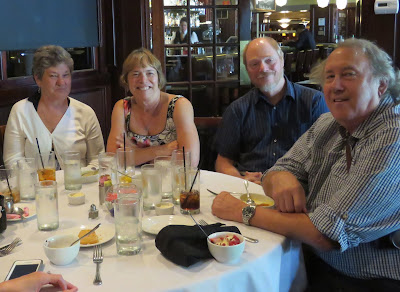July 2018 has been a month of travel, as well as houseguests visiting our house, so I've spent time in my own kitchen and in others. As the summer progresses, I'm trying to use as much local produce as I can, wherever I am. I've shown a lot of photos of my kitchen in the past: this post more emphasizes my dining room and other kitchens I've been in lately. I'm sharing this wrap-up of what I've been doing in July with Sherry's once-a-month blog event, "In My Kitchen."
 |
| Duck with mango & cherries. |
Above: another table setting for guests. Many other bloggers post pictures of their set tables with elaborate themes -- I've decided to feature some of my table settings here, Ikea napkins and all. We mostly emphasize the food, but do try to make our table pretty though simple. I believe the menu served on the above setting was meatballs and mashed potatoes -- not so photogenic.
We had many meals using local farm-fresh products. Above, using a similar table setting, we served a fresh red-and-yellow tomato salad with herbs from our garden. In addition: an omelet of local eggs, which are amazingly excellent, filled with local squash and onions. In the lower-right corner you can see Len's bread. The ceramic dinner plates are the work of my daughter; the serving plates are made by local Ann Arbor potters.
Another dinner at home for 9 people. We enjoyed Sy Ginsberg's corned beef (a Detroit classic) and my own potato salad prepared from locally-grown new redskins. Further back: Carol's bell pepper salad. Just visible in the foreground: Zingerman's bread and sandwich rolls.
A trip to the farmers' market in Lafayette, IN, yielded this beautiful white squash, which I brought back with me and baked for lunch one day. I stuffed the squash with breadcrumbs and topped it with cheese that browned very deeply in the oven.
 |
| Ruby's Kitchen. Ruby was way in back. |
While in St.Louis for my cousin's 90th birthday (posted here) we had brunch in Ruby's kitchen, an extremely pleasant place where we've eaten many meals through the years. On the table you can see bagels, smoked fish, fruit, coffee... typical brunch.
 |
| Elaine's Kitchen. |
Driving between St.Louis and home, we stopped for a couple of nights and several meals at my sister Elaine's. Here she is in her kitchen where we were preparing food from the Lafayette farmers' market.
Lafayette dinner: a medley of farmers-market eggplant, summer squash, and other vegetables; a Caprese salad featuring local Indiana tomatoes and basil from Elaine's garden.
 |
| Eggplant medley decorated with Elaine's home-grown herbs. |
 |
| Elaine also baked a wonderful cheesecake! |
 |
| Back in my own kitchen: fresh corn pancakes frying on the griddle. |
 |
| And the one new thing in our kitchen: a baking stone. Here we are, checking to see if the pizza on the stone has finished baking. |
















































